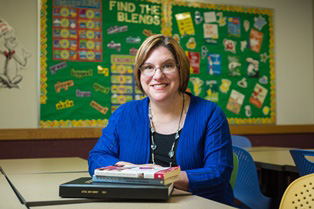
Joyce Mundy, EdD (’90), graduated with a Bachelor of Arts in English and Communication and Secondary Education from Cabrini College, a place that she said served as the foundation for her vision as an educator and educational administrator.
“I can honestly say 25 years later that I still tap into the values and mission of Cabrini in my daily endeavors,” Mundy said.
“The professors at Cabrini helped me recognize my strengths as a leader, and they inspired me to be a lifelong learner who shares my passion for education.”
Now, the 2015 Cabrini Distinguished Achievement Alumni Award recipient is bringing her extensive experience into higher education—she accepted a position as assistant professor of graduate education leadership at Stetson University in Florida this summer—so she can focus on research and education for school leaders.
One focus of her research is bullying prevention, which can be applied at the peer, teacher, and administrator levels, and even at home in family dynamics.
An Educator’s Responsibility
During her 12 years as a classroom teacher, Mundy spent day after day observing the interactions and dynamics between her students. She began to see a link between students’ poor grades or lack of participation and their tendency to withdraw from others in the class.
“I realized in my classroom that the barriers to learning often stemmed from students not feeling safe or valued by their peers or the school community,” she said.
The negative impact of these peer-to-peer relationships on students’ education sparked Mundy’s interest in bullying prevention. And, as her research on the topic progressed, she felt that the best way she could make systemic changes in schools was to become a school administrator.
While an assistant principal at a junior high school, Mundy learned that knowing the impact of their behaviors on others made students more open and willing to be responsible in their interactions.
“That led to creating systemized programs to raise awareness and help students to make these better choices as part of the way the school operated,” she said.
In 2013, Mundy became superintendent of the Centennial School District, which she described as “an opportunity to shape the culture of an entire school system.”
In her effort to build a safe and supportive environment for both students and adults in the school district, Mundy created an effective leadership team at the district and building levels.
“Giving the leadership teams space and opportunity to lead helped us become a dynamic and strong community.”
Dealing with Bullies
As a county and state leader in anti-bullying professional development, Mundy works with teachers and parents to identify signs of bullying and how to tackle the issue. It’s first important to understand why the bullying might be happening in the first place.
It could be something a child learns because of bullying behavior and dynamics at home or because a student is looking to leverage his or her social stature or gain status.
There are many reasons that could perpetuate bullying, which is most common in ages 11 through 15. Mundy explains that bullying is an imbalance of power between a student who bullies and a student who experiences bullying, and that it doesn’t stop in school.
“Students who bully become adults who bully in the workplace, at home, and in relationships,” she said. It’s a problem that not only affects every person in the school or workplace, but also creates long-lasting damage.
So what can you do if you witness bullying in the classroom or at home? Make it a teachable moment, Mundy said. “Take 90 seconds to pause and remind students—or children at home—that careless or unkind behavior isn’t tolerated.”
It’s a message that will resound with the students misbehaving while also demonstrating to the ones being bullied that they have an advocate right there next to them.
“Students report that most bullying happens with adults present, but it is subtle,” Mundy said. “And social media makes it easy to be a hidden culture that happens without adults’ ability to observe.”
Signs that a child is being bullied include a reluctance to go to school or participate in activities, withdrawing or being guarded about sharing information related to relationships with peers, and getting upset over interactions on social media.
Parents should know that schools have a responsibility to investigate bullying behaviors thoroughly and ensure a resolution, even if that means bringing in an outside mediator.
Although schools have anti-bullying programs, Mundy said there remains a strong need to train adults and students in recognizing students in crisis, cultural competence, and the subculture of marginalization.
“Students, and everyone else, need to know that the inclusion of all is non-negotiable.”
This article was featured in Cabrini Magazine.